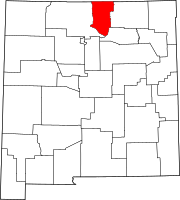|
Arroyo Seco, New Mexico
Arroyo Seco is a census-designated place in Taos County near Taos, New Mexico. Arroyo Seco's economy is based on tourism and services to residents of retirement and vacation homes. Arroyo Seco has a post office, with the ZIP code 87514. The 87514 ZIP Code Tabulation Area had a population of 1,310 at the 2000 census, with 996 housing units, a land area of 53.63 sq. miles, a water area of 0.05 sq. mile, and a population density of 24.43 people per sq. mile at Census 2000. Arroyo Seco's elevation is 7,634 feet.[4] HistoryArroyo Seco was settled in 1804, on a Spanish land grant made on October 7, 1745. The Church of the Most Holy Trinity was completed in 1834 and has recently been restored. [5] Overlooking Arroyo Seco stands Lucero Peak, a 10,780 feet (3,290 m) rock formation. Housed in the Peak is a cave that is sacred to the local Native American population of Taos Pueblo. The cave inspired D.H. Lawrence's short story "The Woman who Rode Away" after he visited it in May 1924 with Mabel Dodge Luhan, her husband Tony, and Lawrence's wife Frieda. Demographics
EducationIt is within Taos Municipal Schools,[7] which operates Taos High School. EventsArroyo Seco's annual Fourth of July parade is locally popular. In cultureThe words "She wrote her name there on my windshield, Just to remind me where she was from' Tina Louise, Arroyo Seco, New Mexico, 1971" in the Commander Cody and the Lost Planet Airmen song "Tina Louise" from their 1976 album Tales from the Ozone. Arroyo Seco is also mentioned in the title of the Fleet Foxes song "I Am All That I Need / Arroyo Seco / Thumbprint Scar" from their 2017 album Crack-Up. Gallery
References
External linksWikimedia Commons has media related to Arroyo Seco, New Mexico.
|
||||||||||||||||||||||||||||||||||||||||||||||||||||||||||||||||













